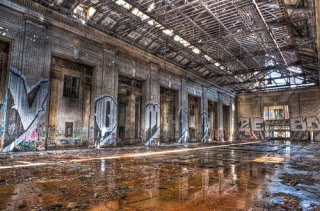ERIC SMITH PHOTOGRAPHS FEATURED IN MUSEUM OF CONTEMPORARY PHOTOGRAPHY EXHIBIT
April 27, 2009 | Source: Monroe Gallery of Photography
 Michigan Central Train Depot, Arrival and Departure Area, 2008
Michigan Central Train Depot, Arrival and Departure Area, 2008The Museum of Contemporary Photography at Columbia College Chicago is proud to present The Edge of Intent, an exhibition looking at the utopian aspirations of urban planners, and how their idealistic visions sometimes become static and incapable of adapting to changing environments and systems. The works in this exhibition warn us of the hazards of "thinking big," while urging us to consider the centrality of dynamism in successful urban design.
The exhibit opening on May 1, 2009 includes a 5:00 pm tour of the works on view by curator Natasha Egan and artists Christina Seely, Tim Long and Andrew Harrison.
This exhibition coincides with the centennial celebration of Daniel Burnhamʼs 1909 plan for the city of Chicago. The exhibition will reflect the centennial celebrationʼs statement of "advancing bold new plans" by encouraging and inspiring viewers to look at the ways urban planning has been instituted in a variety of settings and to learn from the past successes or failures in implementing these plans. By looking through the unique lens these artists provide in their work, the exhibition will challenge the audience to see beyond existing notions of a cityʼs layout and to consider the effects a working plan can have upon an areaʼs inhabitants, and vice-versa. The exhibition includes photographs by Eric Smith, and continue through July 5.
Eric Smith's (American, b. 1947) photographs record the Michigan Central Train Station in Detroit, once a vibrant hub of transportation, but now an abandoned, neglected, and graffiti-strewn monument to Detroit's past. Built in 1913 in the Beaux Arts Style and closed in 1988, the building's marble walls and Doric columns are solidly intact and the space retains its majestic scale. Smith uses digital techniques to depict the station with a sensuous, intensified luminosity, until the photographs resemble meticulously painted illustrations. On a cursory view these photographs can easily be taken for inventive depictions of a mythical setting, similar to Piranesi's subterranean prisons. The station conjures Liset Castillo's deteriorating sand castles, perhaps projecting the fall of both the Roman and the American empires.
"Cities can be tenuous places. As Marco Polo describes the city of Thekla to Kublai Khan:
Those who arrive at Thekla can see little of the city, beyond the plank fences, the sackcloth screens, the scaffoldings, the metal armatures, the wooden catwalks hanging from ropes or supported by sawhorses, the ladders, the trestles. If you ask, "Why is Thekla's construction taking such a long time?" the inhabitants continue hoisting sacks, lowering leaded strings, moving long brushes up and down, as they answer, "So that its destruction cannot begin." And if asked whether they fear that, once the scaffoldings are removed, the city may begin to crumble and fall to pieces, they add hastily, in a whisper, "Not only the city."
— Natasha Egan, Associate Director and Curator
